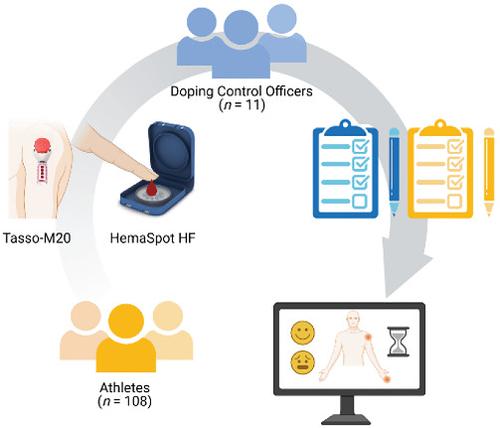当前位置:
X-MOL 学术
›
Drug Test. Anal.
›
论文详情
Our official English website, www.x-mol.net, welcomes your
feedback! (Note: you will need to create a separate account there.)
No pain, just gain: Painless, easy, and fast dried blood spot collection from fingertip and upper arm in doping control
Drug Testing and Analysis ( IF 2.6 ) Pub Date : 2021-08-03 , DOI: 10.1002/dta.3135 Sara Amalie Solheim 1 , Thomas Kamm Ringsted 1 , Nikolai B Nordsborg 2 , Yvette Dehnes 3 , Maren Christin Stillesby Levernaes 3 , Jakob Mørkeberg 1
Drug Testing and Analysis ( IF 2.6 ) Pub Date : 2021-08-03 , DOI: 10.1002/dta.3135 Sara Amalie Solheim 1 , Thomas Kamm Ringsted 1 , Nikolai B Nordsborg 2 , Yvette Dehnes 3 , Maren Christin Stillesby Levernaes 3 , Jakob Mørkeberg 1
Affiliation

|
This study aimed to determine and compare the perception, painfulness, and usability of the minimally invasive dried blood spot (DBS) collections from fingertip versus upper arm from different athlete populations: males and females representing sports dependent on hand/arm, sports less dependent on hand/arm and para-athletes. To accomplish this, 108 national level athletes from Denmark were recruited (♀ = 49, ♂ = 59, 25 ± 6 years; mean ± SD) and 11 Doping Control Officers (DCOs) collected manual fingerprick DBS (HemaSpot HF) and automated upper-arm DBS (Tasso-M20) from each athlete. Athletes and DCOs responded to questionnaires regarding the perception of sample collection procedures. On a 0–10 scale, the athletes reported a low pain score and a very good general experience for both sampling sites, but following upper-arm DBS collection, the associated pain was rated lower (−0.4 ± 1.6, p < 0.05), and the general experience rated better (+0.6 ± 2.3, p ≤ 0.001) than after the fingerprick DBS collection. The DCOs rated the general experience with the upper-arm DBS collection better (+1.6 ± 1.1, p ≤ 0.01) than the fingerprick DBS collection, partly because problems occurred more frequently during the DBS collection from the fingertip (28%) than from the upper arm (6%). In conclusion, it appears that DBS sampling is affiliated with minimal sensation of pain and is preferred by both DCOs and athletes, independent of gender and discipline, over conventional sample collection methods. Collection of DBS from the upper arm was preferred over fingerprick by both athletes and DCOs.
中文翻译:

没有痛苦,只有收获:在兴奋剂控制中从指尖和上臂采集无痛、简单、快速的干血斑
本研究旨在确定和比较来自不同运动员人群的指尖和上臂微创干血斑 (DBS) 采集的感知、疼痛和可用性:男性和女性代表依赖手/手臂的运动,运动较少依赖手/手臂和残疾人运动员。为此,招募了来自丹麦的 108 名国家级运动员(♀ = 49, ♂ = 59, 25 ± 6 年;平均值 ± SD),11 名兴奋剂检查官 (DCO) 收集了手动手指点刺 DBS (HemaSpot HF) 和自动上每个运动员的手臂 DBS (Tasso-M20)。运动员和 DCO 对关于样本收集程序感知的问卷做出了回应。在 0-10 的范围内,运动员报告了两个采样点的低疼痛评分和非常好的一般体验,但在上臂 DBS 采集后,p < 0.05),一般经验的评分比指刺 DBS 采集后更好 (+0.6 ± 2.3, p ≤ 0.001)。DCO 对上臂 DBS 采集的一般体验的评价比指刺 DBS 采集更好 (+1.6 ± 1.1, p ≤ 0.01),部分原因是指尖 DBS 采集过程中出现的问题 (28%) 比从指尖采集更频繁。上臂(6%)。总之,与传统的样本采集方法相比,DBS 采样似乎与最小的疼痛感有关,并且不受性别和学科的影响,更受 DCO 和运动员的青睐。运动员和 DCO 都更喜欢从上臂采集 DBS,而不是手指采血。
更新日期:2021-08-03
中文翻译:

没有痛苦,只有收获:在兴奋剂控制中从指尖和上臂采集无痛、简单、快速的干血斑
本研究旨在确定和比较来自不同运动员人群的指尖和上臂微创干血斑 (DBS) 采集的感知、疼痛和可用性:男性和女性代表依赖手/手臂的运动,运动较少依赖手/手臂和残疾人运动员。为此,招募了来自丹麦的 108 名国家级运动员(♀ = 49, ♂ = 59, 25 ± 6 年;平均值 ± SD),11 名兴奋剂检查官 (DCO) 收集了手动手指点刺 DBS (HemaSpot HF) 和自动上每个运动员的手臂 DBS (Tasso-M20)。运动员和 DCO 对关于样本收集程序感知的问卷做出了回应。在 0-10 的范围内,运动员报告了两个采样点的低疼痛评分和非常好的一般体验,但在上臂 DBS 采集后,p < 0.05),一般经验的评分比指刺 DBS 采集后更好 (+0.6 ± 2.3, p ≤ 0.001)。DCO 对上臂 DBS 采集的一般体验的评价比指刺 DBS 采集更好 (+1.6 ± 1.1, p ≤ 0.01),部分原因是指尖 DBS 采集过程中出现的问题 (28%) 比从指尖采集更频繁。上臂(6%)。总之,与传统的样本采集方法相比,DBS 采样似乎与最小的疼痛感有关,并且不受性别和学科的影响,更受 DCO 和运动员的青睐。运动员和 DCO 都更喜欢从上臂采集 DBS,而不是手指采血。











































 京公网安备 11010802027423号
京公网安备 11010802027423号